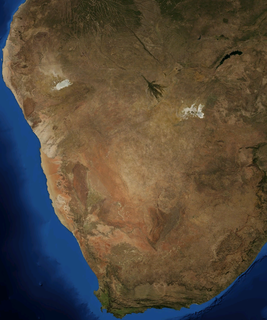
The Kalahari Desert is a large semi-arid sandy savanna in Southern Africa extending for 900,000 square kilometres (350,000 sq mi), covering much of Botswana, and parts of Namibia and South Africa.

The Okavango River, Also known as the Cubango River, is a river in southwest Africa. It is the fourth-longest river system in southern Africa, running southeastward for 1,600 km (1,000 mi). It begins at an elevation of 1,300 metres (4,300 ft) in the sandy highlands of Angola. Farther south, it forms part of the border between Angola and Namibia, and then flows into Botswana. The Okavango does not have an outlet to the sea. Instead, it discharges into the Okavango Delta or Okavango Alluvial Fan, in an endorheic basin in the Kalahari Desert.

The Okavango Delta in Botswana is a swampy inland delta formed where the Okavango River reaches a tectonic trough at an altitude of 930–1,000 m in the central part of the endorheic basin of the Kalahari. All the water reaching the delta is ultimately evaporated and transpired and does not flow into any sea or ocean. Each year, about 11 cubic kilometres (2.6 cu mi) of water spreads over the 6,000–15,000 km2 (2,300–5,800 sq mi) area. Some flood waters drain into Lake Ngami. The area was once part of Lake Makgadikgadi, an ancient lake that had mostly dried up by the early Holocene.
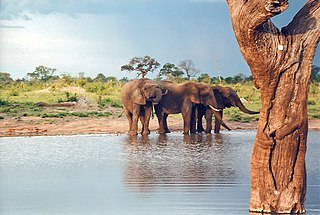
Hwange National Park is the largest natural reserve in Zimbabwe. It is around 14,600 sq km in area. It lies in the northwest of the country, just off the main road between Bulawayo and Victoria Falls. The nearest town is Dete. Histories of the region's pre-colonial days and its development as a game reserve and National Park are available online

The Pilanesberg National Park is located north of Rustenburg in the North West Province of South Africa. The park borders on the Sun City entertainment complex. It is currently administered by the North West Parks and Tourism Board.

Khwai is a village on the north bank of the Khwai River in the North-West District of Botswana. The river is the northern boundary of the Moremi Game Reserve, and the village is just outside the north gate of the reserve, which is on the eastern side of the Okavango Delta.

The wildlife of Botswana refers to the flora and fauna of this country. Botswana is around 90% covered in savanna, varying from shrub savanna in the southwest in the dry areas to tree savanna consisting of trees and grass in the wetter areas. Even under the hot conditions of the Kalahari Desert, many different species survive; in fact the country has more than 2500 species of plants and 650 species of trees. Vegetation and its wild fruits are also extremely important to rural populations living in the desert and are the principal source of food, fuel and medicine for many inhabitants.

The Zambezian flooded grasslands is an ecoregion of southern and eastern Africa that is rich in wildlife.

Botswana's principal tourist attractions are its game reserves, with hunting and photographic safaris available. Other attractions include the Okavango Delta region, which during the rainy season is a maze of waterways, islands, and lakes. The tourism industry also helped to diversify Botswana's economy from traditional sources such as diamonds and beef and created 23,000 jobs in 2005.
John McNutt, known as Tico McNutt, started the Wild Dog Research Project in 1989. His research in that field has been supported in part by the National Geographic Society. He received a doctorate in animal behavior from the University of California in 1995. At the time, he founded the Botswana Wild Dog Research Project as little was known about the biology of the African wild dog, though it was believed to be one of the most endangered canine species. Since then, Tico has followed many wild dog packs in Botswana’s Okavango Delta, eventually expanding his studies to include all major predators in the region.

The Kalahari Acacia-Baikiaea woodlands are an ecoregion located in Botswana, northern Namibia, South Africa and Zimbabwe.
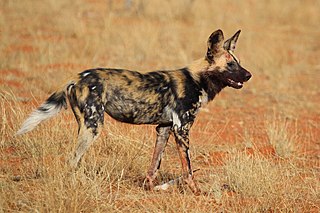
The African wild dog, also called the painted dog or Cape hunting dog, is a wild canine which is a native species to sub-Saharan Africa. It is the largest wild canine in Africa, and the only extant member of the genus Lycaon, which is distinguished from Canis by dentition highly specialised for a hypercarnivorous diet, and by a lack of dewclaws. It is estimated that about 6,600 adults live in 39 subpopulations that are all threatened by habitat fragmentation, human persecution, and outbreaks of disease. As the largest subpopulation probably comprises fewer than 250 individuals, the African wild dog has been listed as endangered on the IUCN Red List since 1990.
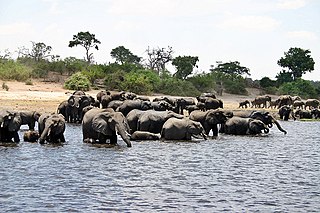
Kavango–Zambezi Transfrontier Conservation Area was a conservation proposal for a region of Southern Africa where the international borders of five countries converge. It was to include a major part of the Upper Zambezi River and Okavango basins and Delta, the Caprivi Strip of Namibia, the southeastern part of Angola, southwestern Zambia, the northern wildlands of Botswana and western Zimbabwe. The centre of this area is at the confluence of the Zambezi and Chobe Rivers where the borders of Botswana, Namibia, Zambia and Zimbabwe meet. It would have incorporated Chobe National Park, Hwange National Park, and the Victoria Falls.

Painted Dog Conservation was founded in 1992 by wildlife conservation biologist Greg Rasmussen for the protection of the painted dogs and their habitat. Painted Dog Conservation works to engage and incorporate local communities in protecting painted dogs in Zimbabwe. The painted dog, or African wild dog, was once common in Africa with estimates of over half a million spread among 39 countries. Current estimates put their numbers at about 3,000 only found in Tanzania, Zambia, Mozambique, Zimbabwe, Botswana and South Africa. Since PDC's creation, Zimbabwe's wild dog population has increased from 400 to 700 individuals. Painted Dog Conservation is partnered with the Wildlife Conservation Network.

Mudumu is a National Park in Caprivi Region in north-eastern Namibia. The park was established in 1990. It covers an area of 737 square kilometres (285 sq mi). The Kwando River forms the western border with Botswana. Various communal area conservancies and community forests surround Mudumu National Park.

The Mahango Game Park is a protected area in Namibia within Bwabwata National Park. It is situated at the country's eastern border with Botswana in the flood plains of the Okavango River basin, close to the Popa Falls on the river. The Caprivi Strip encloses the western part of the park. It was established in 1986 and covers an area of 24,462 hectares. With over 300 species of birds, it has been designated an Important Bird Area by BirdLife International. About two thirds of the bird species found in Namibia are located here as it includes both wetland and tropical terrestrial species of birds.
Belmond Khwai River Lodge is a safari lodge situated in Moremi Game Reserve, part of the Okavango Delta in Botswana. The lodge is one of three that comprise Belmond Safaris, the others being Belmond Eagle Island Lodge and Belmond Savute Elephant Lodge. All three are reached from Maun, Botswana.
Okavango Delta region is one of the subdistricts of Ngamiland District of Botswana.
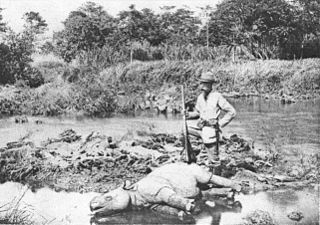
Rhinoceros poaching in southern Africa is the illegal act of slaughtering rhinoceros in the southern African countries of Namibia, Botswana, Zimbabwe and South Africa, where most of Africa's rhinos occur. The most common reason for rhino poaching is to meet the high demand for their horns in Asian countries, where the horn is predominantly used in Traditional Chinese Medicine but is increasingly being used as a symbol of wealth and prosperity. In previous generations, the most common rhino poaching activity was hunting for recreational purposes. Because of excessive poaching, rhino populations have decline rapidly since the 1970s, leaving some species critically endangered and facing extinction.


















